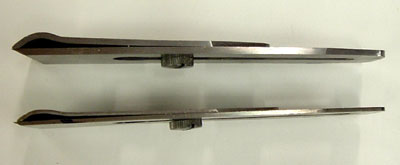Ask the Staff
 Question:
I was looking at the Anant planes in your catalog and I'm having a bit of trouble understanding the difference between the standard Anant planes and the new Kamals. Are they really that different and are they worth the extra money?
Question:
I was looking at the Anant planes in your catalog and I'm having a bit of trouble understanding the difference between the standard Anant planes and the new Kamals. Are they really that different and are they worth the extra money?
Answer:
As stated in our catalog,
Kamal bench planes
represent
Anant's
premium line of planes. This being the case, Anant's standard line of planes isn't bad either. We believe both to be excellent values. You get far more plane in either case than you would expect given the price. Below I've compared both lines of the Anant planes and detailed the differences between the two.
IRONS AND CHIP BREAKERS
 Kamal bench plane irons are nearly 1/8" thick! The standard irons run 5/64", which is still thicker than most vintage Stanley's. In general, a thicker iron means less chatter and fewer marks left on the wood. A thicker iron or cutter also allows you to move the frog forward to close up the throat opening without having the unsupported end of the blade flopping in the breeze. For the most part, a tighter throat means you'll experience less tear out on the face of the wood when planing. A tight throat is especially desired on smoothing planes (#3 and #4) where the planed surface will be seen.
Kamal bench plane irons are nearly 1/8" thick! The standard irons run 5/64", which is still thicker than most vintage Stanley's. In general, a thicker iron means less chatter and fewer marks left on the wood. A thicker iron or cutter also allows you to move the frog forward to close up the throat opening without having the unsupported end of the blade flopping in the breeze. For the most part, a tighter throat means you'll experience less tear out on the face of the wood when planing. A tight throat is especially desired on smoothing planes (#3 and #4) where the planed surface will be seen.
The chip breakers on the Kamals are also 1/8" thick. Having a stouter chip breaker adds additional support and heft to the cutting edge, and therefore dampens blade vibration. Again, this is more important on smoothing planes that have the frog in a forward position.
MACHINING AND WEIGHT
Anant does a pretty good job of machining their tools. In fact, of all the iron bodied, Bailey pattern planes coming out of Asia at this time, Anant's machining is far and away the best, and that goes for both of their lines. To finish rough castings on their standard line, Anant sands all surfaces. On their Kamal line, they machine grind working surfaces. If you're someone who likes to polish plane bodies to a high shine, then you'll appreciate the Kamal series' finish, and you'll have far less work to do. On both lines, Anant manages to get things reasonably flat and true. However, the machining on the frogs is nicer on the Kamals, but this is mostly aesthetic rather than practical. Any minor blemish that does pop up is almost always remedied with a quick stroke of a file.
Each Kamal plane is slightly heavier than its standard counterpart. For instance, a
Kamal 4-1/2 (199403)
weighs in at 5.25 lb while the
standard 4-1/2 (199203)
is 4.5 lb. The Kamal castings are slightly thicker. We'll let you debate the merits of hand plane mass.
HARDWARE, KNOBS AND TOTES
 Both Anant bench plane lines come with wooden handles (knobs and totes). For some unknown reason, Anant insists on putting a plastic knob in the bullnose position of their otherwise brilliant
78 Standard Rabbet Plane (199208)
. The original Stanley and Record never had this. We recommend you remove the offending knob and toss it out. Ah, much better. Anyway, Kamals get brass buttons, screws, wheels and levers while the regular Anants come issued with zinc hardware.
Both Anant bench plane lines come with wooden handles (knobs and totes). For some unknown reason, Anant insists on putting a plastic knob in the bullnose position of their otherwise brilliant
78 Standard Rabbet Plane (199208)
. The original Stanley and Record never had this. We recommend you remove the offending knob and toss it out. Ah, much better. Anyway, Kamals get brass buttons, screws, wheels and levers while the regular Anants come issued with zinc hardware.
FINAL THOUGHTS
We like Anant products because, let's face it, not all of us can afford a $350 handplane. Anant gives you value for your money and much better than average quality. With the addition of the Kamal line, you have a real choice when it comes to premium planes. It's a cliché, but you will always come out on top buying the best you can afford. Generally speaking, quality is more critical on smaller planes that produce finished surfaces, surfaces that will be seen, and less important on larger planes designed for surface preparation or stock removal. Many woodworkers spend the bulk of their plane budget on a smoothing plane and a block plane and less on a jointer and jack. Of course, quality is its own reward and having nice tools is a luxury worth pursuing. Now, as nice as these tools are don't think for a minute you won't have some tuning and sharpening to do on these planes. So roll up your sleeves and get to work. For further reading on tuning metal planes, please check out my article,
Tuning Metal Bench Planes for the Rest of Us
.
Chris Black